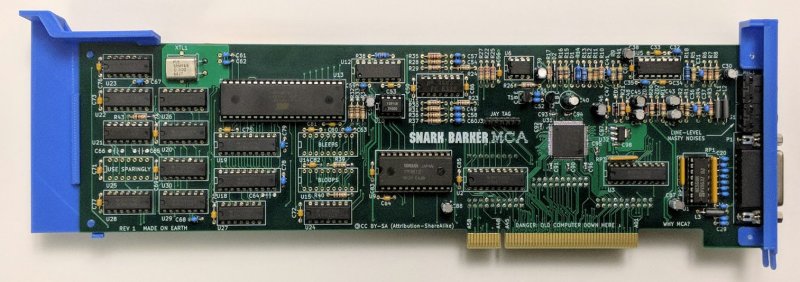Not many people today probably remember what ‘Micro Channel Architecture’ was about, though its acronym ‘MCA’ might ring a bell. Created by IBM to replace ISA (Industry Standard Architecture) and presumably claw back some of that sweet, sweet licensing money, it didn’t quite pan out as IBM hoped. As history shows us, PCI ended up replacing MCA in all of IBM’s systems. The IBM PS/2 systems that used MCA didn’t miss out on classic 1990s cards, such as the original Sound Blaster, but today MCA versions of the Sound Blaster are admittedly rather… rare, not to mention expensive.
But, no longer: decades after the last PS/2 users have moved on, [Tube Time] proudly presents the Snark Barker MCA. It’s a fully Sound Blaster compatible sound card. It supports AdLib synthesis, digital sound playback and recording, as well as a joystick input and MIDI. Based around a Xilinx XC9572XL CPLD and featuring what looks like a full-length MCA card, it would have made an original Sound Blaster card proud.
The GitHub repository not only contains the schematics, BOM and Verilog-based HDL for the CPLD, but also extensive documentation on the assembly and programming. As a bonus, there’s a troubleshooting section which covers some of the joys that came with the sloppy implementations of MCA across systems. Definitely worth a read.
If anyone decides to build this project and use it in their IBM PS/2 system, we would love to hear about it.
Of course, if all you need is a garden variety PCI Sound Blaster clone, the original Snark Barker is the way to go.
(Thanks, Darry)















I think you mean “…if all you need is a garden-variety ISA Sound Blaster clone”. The one depicted in the final line of the article is decidedly not PCI.
Micro channel, aka possibly the beginning of RadioShack’s blundertrail of poor decisions. Decidedly, IBM’s declaration of, “We hate this thing & don’t know what to do”.
It wasn’t quite as bad an idea as the “Sensation!”
I’m kinda surprised they didn’t build a Snark Barker 16. I think it might be possible to actually buy new or old stock OPL3 compatible FM chips. Meanwhile I assume any OPL2s on the market are probably from board recyclers.
Ah yes, the Tandy 5000 MC (25-6000 if I remember correctly) The home office sent us three, one went on display, and the other two sat in the back collecting dust until they told us to ship them back.
The school district I worked for in 1989 purchased hundreds of IBM 386 PS/2 machines for all their schools. All featured MCA architecture and token ring networking running Novell Netware 2.2. I had one last working network as of 2003 ( just for fun ).
Anyways… “backing the wrong horse/seemed like a good idea at the time” and all that…
Ah, MCA. Had a card that was MCA on one edge, and ISA on the other.
Ah MCA, a big FU from Big Blue, and they got what they deserved.
Anyone remember EISA?
https://en.wikipedia.org/wiki/Extended_Industry_Standard_Architecture
Sure. EISA solved a problem in a non-proprietary way. MCA did not.
Vesa Local Bus was rather good. You could get quick HDD adapters as well as graphics adapters. I used to clock mine at 50 MHz, which wasn’t supposed to work but did mostly. I don’t *remember* any data corruption, which isn’t to say that it didn’t happen.
Oh, yes. My MIcronics 80486 ASIC EISA system was a direct thumb nose at MCA by the “Gang of Nine”.
32 bit bus slots backward compatible with 8 and 16 bit ISA as well as the VLB for a dedicated graphics card, man, I thought I was something with 64mb of DRAM and 1 Gb SCSI Seagate!
All those jumper settings, though…and the SCSI peripheral chain…..external CD ROM….Bernoulli 150…..Flatbed scanner….
Last thing I added was an EISA to USB adapter(Now there’s some vaporware!). So much easier than SCSI, but so slow.
That was the retirement signal
I am surprised there aren’t more modern-built (and open source) MCA cards out there for all those geeks who have old PS2s around or something.
Heck, I am sure an MCA video card would be very popular (build one using a FPGA or get an “SVGA” chip from somewhere (like the one they are using on that XT clone board).
I still have one of the original SoundBlaster Microchannel cards for the PS/2. Its in my P70 brief case machine with its huge 120Meg hard drive with Stacker loaded on it to make the drive bigger.
🤔 I have a mico channel sound baster card ….
Is it more valuable than gold 🤔